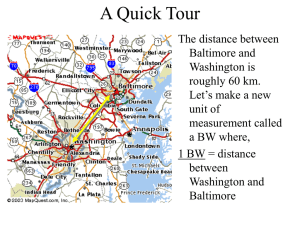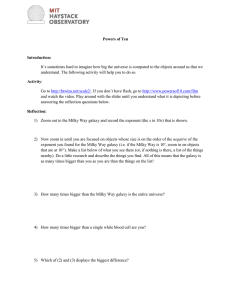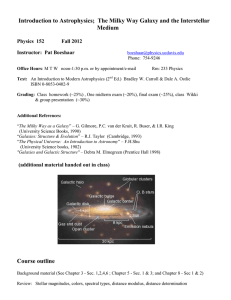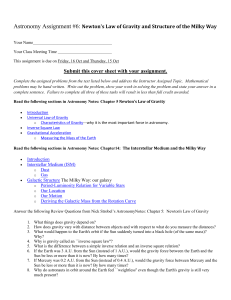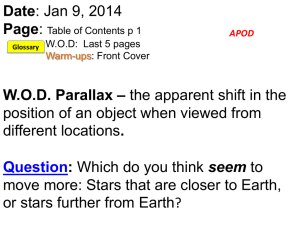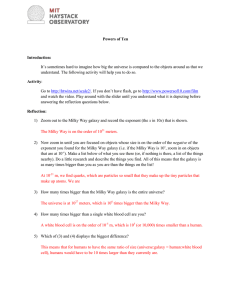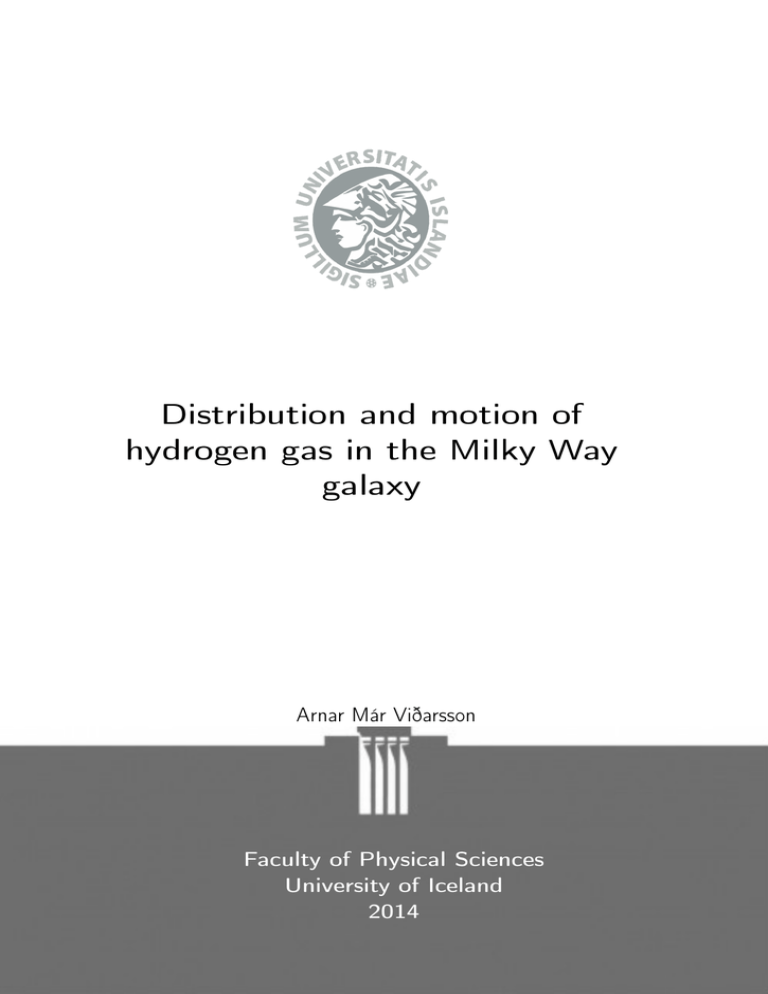
Distribution and motion of
hydrogen gas in the Milky Way
galaxy
Arnar Már Viðarsson
Faculty
Faculty of
of Physical
Physical Sciences
Sciences
University
University of
of Iceland
Iceland
2014
2014
DISTRIBUTION AND MOTION OF HYDROGEN
GAS IN THE MILKY WAY GALAXY
Arnar Már Viðarsson
16 ECTS thesis submitted in partial fulfillment of a
Baccalaureus Scientiarum degree in physics
Advisor
Guðlaugur Jóhannesson
Faculty of Physical Sciences
School of Engineering and Natural Sciences
University of Iceland
Reykjavik, November 2014
Distribution and motion of hydrogen gas in the Milky Way galaxy
16 ECTS thesis submitted in partial fulfillment of a B.Sc. degree in physics
c 2014
Copyright All rights reserved
Arnar Már Viðarsson
Faculty of Physical Sciences
School of Engineering and Natural Sciences
University of Iceland
Hjarðarhaga 2-6
107, Reykjavik, Reykjavik
Iceland
Telephone: +354-525-4000
Bibliographic information:
Arnar Már Viðarsson, 2014, Distribution and motion of hydrogen gas in the Milky Way
galaxy, B.Sc. thesis, Faculty of Physical Sciences, University of Iceland.
Printing: Háskólaprent, Fálkagata 2, 107 Reykjavík
Reykjavik, Iceland, November 2014
Abstract
We explored methods of observing hydrogen gas within the Milky Way galaxy and its
motion. We derive expression for velocity of observed gas relative to local standard
of rest to model the motion of the interstellar matter and show how we use this
model to find the distribution of neutral hydrogen gas throughout the galaxy. We
use the LAB data of the 21-cm neutral hydrogen line and apply this model to the
data. This model is quite simple and we are ignoring things like turbulence of the gas
and we assume the gas moves around the galactic center in perfect circular motion.
We calculate the column density of the gas of annuli and find that the distribution
of the gas is most concentrated in the galactic plane. As we move out from the
center the gas distributes more above and below the plane. We also find that the
galactic plane warps at the outer edges of the Milky Way.
v
Contents
List of Figures
1 The
1.1
1.2
1.3
Milky Way galaxy
Looking into the sky . . . .
The Interstellar medium . .
Motion of Interstellar matter
1.3.1 The Doppler effect .
ix
.
.
.
.
1
1
1
3
5
2 Methods to detect and observe hydrogen gas
2.1 The 21-cm line . . . . . . . . . . . . . . . . . . . . . . . . . . . . . .
2.2 The CO luminosity to H2 mass conversion factor XCO . . . . . . . . .
7
7
8
. . . .
. . . .
within
. . . .
. . . . . .
. . . . . .
the Milky
. . . . . .
. . . . . . .
. . . . . . .
Way galaxy
. . . . . . .
.
.
.
.
.
.
.
.
.
.
.
.
.
.
.
.
.
.
.
.
3 Calculation of observed 21-cm line data
9
3.1 Deriving the total column density of H i . . . . . . . . . . . . . . . . 9
3.2 Column density of annular distribution . . . . . . . . . . . . . . . . . 12
4 Conclusions
15
Bibliography
17
vii
List of Figures
1.1
1.2
1.3
2.1
Galactic rotation. C in the Milky-Way center, S is the sun, M is the
observed cloud, V is the velocity of the cloud and the green line is
the line of sight . . . . . . . . . . . . . . . . . . . . . . . . . . . . . .
4
The velocity relative to the local standard of rest with clockwise rotation. The blue region of the figure is gas and dust moving towards
the sun and the red region is moving away from the sun. The center
point in the figure is the center of the Milky Way and the star shows
where the sun is located. . . . . . . . . . . . . . . . . . . . . . . . . .
4
The natural logarithm of the gradient of the velocity of local standard
of rest with respect to distance to observed object. The circle that
forms from the sun to the center of the Milky Way traces the tangent
points for different radii. . . . . . . . . . . . . . . . . . . . . . . . . .
5
The spin flip from the higher energy state to the lower energy state
in the neutral hydrogen atom emitting the 21-cm radiation. . . . . . .
7
3.1
Results of the 21-cm data. (a) shows the column density of H i in the
Milky Way using TS = 160K, (b) shows the column density of H i in
the Milky Way using TS = 5000K and (c) shows the difference in the
column density between the two values. . . . . . . . . . . . . . . . . . 11
3.2
Column density of H i gas in annular distribution. (a) having R in
the range 0 - 2 kpc, (b) having R in the range 2 - 4 kpc, (c) having R
in the range 4 - 6 kpc, (d) having R in the range 6 - 8 kpc, (e) having
R in the range 8 - 10 kpc, (f) having R in the range 10 - 15 kpc and
(g) having R > 15 kpc. . . . . . . . . . . . . . . . . . . . . . . . . . . 13
ix
1 The Milky Way galaxy
1.1 Looking into the sky
On a dark and clear night one can look up to the sky and see a luminous band
running across the dark sky. This luminous band is our galaxy and we have given
it the name the Milky Way. Our sun is only one of a hundred billions of stars that
make the Milky Way. The Milky Way not only consists of stars but also gas, dust
and dark matter. Dark matter has not been directly observed but observations of
motion of gas and dust within the Milky Way have shown that there is something
there that we can not see. Our solar system is located ∼8.5 kpc (about 27.700 light
years) from the galactic center in one of the Milky Way’s spiral arms. The reason
why we see the Milky Way as a band running across the sky is that the solar system
is in the galactic plane. One can not see the whole structure and distribution of gas
and dust in the Milky Way without sending a satellite to photograph the Milky Way
from high above the galactic plane, but that is not going to happen any time soon
because of the wast distances in outer space. To put it into perspective our nearest
neighbouring solar system is Proxima Centauri little over 4 light years away and
getting there with modern technology, traveling at speeds of 40.000 km/h, would
take 110.000 years and another 110.000 years back. We can on the other hand see
the structure from the inside and we have developed methods to find the structure
and distribution of gas and dust in the Milky Way that will be discussed in this
paper. We now know with observation and modeling [8] of our own galaxy and
other galaxies that the Milky Way has distribution of gas, dust and stars that forms
a spiral like structure [2].
1.2 The Interstellar medium
The wast space between the stars in the galaxy is filled with gas and dust. All this
gas and dust we call the Interstellar medium (ISM). This gas and dust can condense
into stars and form new solar systems. In the end of the life of the star it will expel
its gas back into space. The gas within the ISM is composed of multiple different
phases depending on whether the gas is molecular, atomic or ionized. Most common
1
1 The Milky Way galaxy
element in the ISM is hydrogen followed by helium and trace amounts of carbon,
oxygen and nitrogen. Interstellar matter accounts for ∼10-15% of the total mass of
the galactic disk and it spreads in the galactic plane along the spiral arms. About
90.8% of the gas in the Interstellar matter are hydrogen atoms, 9.1% helium and
the 0.12% are heavier elements [5].
Molecular clouds have density of 102 − 106 atoms cm−3 and temperatures of
10-20K, they are dark and block off light from stars behind them [5]. The density
and size of the clouds permits the formation of molecules, most commonly molecular
hydrogen (H2 ). To detect the mass of H2 one uses the luminosity of carbon monoxide
(CO) [1]. Molecular clouds have sometimes been called stellar nurseries because of
frequent star-formation within the clouds [7].
Cold Neutral Medium (CNM) clouds have density of 20 − 50 atoms cm−3 ,
temperatures of about 20-400K and are usually denoted by H i. H i emission can
not be directly observed at optical wavelengths but absorption can be seen at optical
wavelengths. In neutral atomic clouds particle collisions are so rear that almost all
hydrogen atoms have their electron in the lowest energy level [5] and it can be
observed by its emission and absorption of the 21-cm hydrogen line which will be
discussed in chapter 2.1.
The Warm Neutral Medium (WNM) has density of 0.2 − 0.5 atoms cm−3 and
temperatures of 6000-10000K [5] and can be observed by the emission of the 21-cm
hydrogen line.
The Warm Ionized Medium (WIM) has the same density as the WNM and
temperatures of 8000K [5]. It is mostly photoionized although there is evidence of
shock or collisional ionization high above the galactic plane. The WIM is observed
by Hα emission and pulsar dispersion.
The Hot Ionized Medium (HIM) has density of ∼ 0.0065 atoms cm−3 and
temperatures of ∼ 106 K [5]. This gas is heated by supernovae and appears as
bubbles. it is mainly observed by X-ray emission and absorption lines in the farUV.
Gas that is in between these temperatures is not stable and can thus not be classified
under any of these phases of the ISM.
2
1.3 Motion of Interstellar matter within the Milky Way galaxy
1.3 Motion of Interstellar matter within the Milky
Way galaxy
We need to derive an equation that will describe the motion the stars, gas and dust
around the galactic center. So we have to consider the galactic coordinate system.
The galactic coordinate system is a celestial coordinate system with the Sun as its
center. The galactic longitude measures the angular distance positive to eastward
from the galactic center and the galactic latitude measures the angular distance
positive to the north. From figure 1.1 we get the equation for VLSR on flat rotation
disk.
VLSR = V cos(α) − V0 sin(l)
where l is the galactic longitude. By replacing cos(α) with R0 /R sin(l) and assuming
V = V0 we get
!
R0
− 1 sin(l)
VLSR = V0
R
But we live in three dimensional world so we need to add a term for the galactic
latitude in (VLSR )
!
R0
VLSR = V0
− 1 sin(l)cos(b)
(1.1)
R
where b is the galactic latitude. Although this is a very simple model it gives a good
idea of the motion of gas and dust within the galaxy and the results are shown on
figure 1.2 where we have V0 = 220 km/h and R0 = 8.5 kpc [5]. The figure shows us
that this is a good approximation for the motion of gas in the galaxy. If the gradient
of the VLSR is big then it is easy to use VLSR to determine the radius of a cloud from
the center of the Milky Way.
V0 R0 sin(l)(d − R0 cos(l))
dVLSR
=− 2
dd
(R0 − 2dR0 cos(l) + d2 )3/2
(1.2)
The gradient is shown figure 1.3 and we can see where the gradient is low is when l
is close to 0◦ or 180◦ and in the circle that traces the tangent point and in chapter
3.2 we will see what effect it will have on the results.
3
1 The Milky Way galaxy
Figure 1.1: Galactic rotation. C in the Milky-Way center, S is the sun, M is the
observed cloud, V is the velocity of the cloud and the green line is the line of sight
Figure 1.2: The velocity relative to the local standard of rest with clockwise rotation.
The blue region of the figure is gas and dust moving towards the sun and the red
region is moving away from the sun. The center point in the figure is the center
of the Milky Way and the star shows where the sun is located.
4
1.3 Motion of Interstellar matter within the Milky Way galaxy
Figure 1.3: The natural logarithm of the gradient of the velocity of local standard
of rest with respect to distance to observed object. The circle that forms from the
sun to the center of the Milky Way traces the tangent points for different radii.
1.3.1 The Doppler effect
When we observe the 21-cm line of hydrogen gas we learn about the motion of the
hydrogen clouds because of the Doppler effect. The Doppler effect describes the
change in frequency of a moving object and can be experienced in everyday life. The
frequency of the 21-cm line is related to how fast the gas is moving towards us or
how fast it is moving away from us. This relation is described with
v
f − f0
=−
f0
c
(1.3)
where f is the observed frequency, f0 is the frequency of the 21-cm line and v is the
velocity of the gas cloud, >0 if the cloud is receding or <0 if the cloud is approaching.
5
2 Methods to detect and observe
hydrogen gas
There are three main methods of detecting and analyzing interstellar gas, the 21cm neutral hydrogen line, spectra lines from molecules and emission lines from hot
ionized gas. Here we will discuss two methods, the emission and absorption of the
21-cm hydrogen line and how we can use the luminosity of the 2.6mm CO spectra
line to find H2 density.
2.1 The 21-cm line
The 21-cm line was first predicted by Dr Hendrik van de Hulst in 1944. He predicted
that neutral hydrogen could produce radiation at a frequency of 1420.4058MHz and
wavelength of 21.1 cm [4]. This is due to the hyperfine structure of the ground state
of hydrogen. Neutral hydrogen has one electron and the hyperfine structure is due
to the relative spin of the electron to the proton. Parallel spin (higher energy state)
and the anti-parallel spin (lower energy state). When the hydrogen is in the higher
energy state and the spin of the electron flips, the energy of the hydrogen drops to
the lower energy state and the hydrogen emits radiation at the before mentioned
frequency and wavelength. The emission is in the radio part of the spectrum and
passes easily through interstellar gas and dust but can be absorbed by hydrogen in
the CNM.
Figure 2.1: The spin flip from the higher energy state to the lower energy state in
the neutral hydrogen atom emitting the 21-cm radiation.
7
2 Methods to detect and observe hydrogen gas
2.2 The CO luminosity to H2 mass conversion
factor XCO
Molecular hydrogen (H2 ) in cold molecular clouds can not be observed directly.
Fortunately molecular clouds are not pure H2 but also contain helium and heavier
elements such as carbon and oxygen. Carbon and oxygen are the most abundant and
under certain circumstances, which are present in molecular clouds, they combine
to form CO. CO is easily excited due to it is weak permanent dipole moment and
a ground rotational transition with low excitation energy. With wavelength of λ =
2.6mm the transition J = 1 → 0 is easily observed [1].
There are three independent calibration techniques used to determined the conversion factor. The first technique uses the optically thin 13 CO intensities and measurements of optical extinction along the line of sight through the molecular cloud.
The calibration for 12 CO then obtained from observed average ratio of I(13 CO) to
I(12 CO). The second technique uses γ-rays from cosmic ray interaction with hydrogen gas and compares the γ-ray flux to the CO flux. The third technique measure
the virial mass for molecular clouds in the galactic plane [1, 9].
The relation between molecular hydrogen and the intensity of CO is described by
N (H2 ) = XCO W (CO)
(2.1)
where the column density is in cm−2 and W (CO) is the integrated line intensity.
This corresponds to a molecular mass to CO luminosity ratio
Mmol = αCO LCO .
(2.2)
Where αCO is mass-to-light ratio and LCO is CO luminosity. XCO has found to be
2 × 1020 cm−2 ( K km s−1 )−1 and with corresponding αCO = 4.3 M (K km s−1 pc2 )−1
[1].
8
3 Calculation of observed 21-cm
line data
This paper uses the LAB survey data of the 21-cm line [6]. The Leiden Argentine
Bonn (LAB) survey is the final data release of observations of 21-cm emission from
neutral hydrogen over the entire sky combined from the Leiden/Dwingeloo survey
(LDS) and Instituto Argentino de Radioastonomía survey (IAS). The LAB survey is
the most sensitive survey of the 21-cm H i emission of the whole Milky Way galaxy
to date. The data is released as brightness temperature as function of longitude,
latitude and velocity of local standard of rest [6]. The measurement itself is intensity,
I, but in radio spectroscopy I is often replaced with brightness temperature. The
brightness temperature is defined at low frequency and high temperatures with the
Rayleigh-Jeans law
2ν 2 kT
(3.1)
Tb =
c2
where ν is the frequency, k is the Boltzmann constant, T is the kinetic temperature
of the cloud and c is the speed of light [10].
3.1 Deriving the total column density of H i
The 21-cm line of H i has an opacity at the line center of
τ = 5.2 × 10−15
NH
∆vTs
(3.2)
where Ts is the spin temperature, NH is the column density and ∆v is the full width
at half-maximum in km/s [4]. Spin temperature describes the ratio between the
number of H i atoms in the higher energy state (E2 ) and the number of H i atoms
in the lower energy state (E1 ). This can be expressed with the Boltzmann factor
∆E g2
NE2
= exp −
NE1
g1
kTs
where g2 /g1 is the statistical weight ratio for hyperfine transition. The spin temperature is generally not known so we have to select our own for our calculations. To
9
3 Calculation of observed 21-cm line data
simplify we assume that the spin temperature is a constant throughout the galaxy.
The brightness temperature is a mix of emission and absorption at a velocity v. We
assume the spin temperature is a constant throughout the galaxy we can define the
brightness temperature as
∆Tb (v) = [Ts − T0 ][1 − e−τ (v) ]
(3.3)
where T0 is the background temperature. If Tb << Ts then we can define the total
column density of H i is given by a velocity integral under the profile (in K km/s)
Z
15
NH = 1.823 × 10
Tb dv
(3.4)
Now to fully derive the equation for the total column density of H i we combine
equations (3.2), (3.3) and (3.4) and then assume everything under the integral is
constant we get
NH = −1.823 × 1015 ln 1 −
Tb Ts ∆v
Ts − T0
(3.5)
We can apply this to the LAB data and manually select the Ts . The results can
be seen on figure 3.1. Because the value of Ts is not generally known and as can
be seen on figure 3.1 choosing the value of Ts can greatly affect the results of the
column density of H i. By choosing Ts = 160K we get almost two times higher
column density then choosing Ts = 5000K, we could be over-, underestimating or
be lucky and choosing the right value for Ts .
10
3.1 Deriving the total column density of H i
(a)
(b)
(c)
Figure 3.1: Results of the 21-cm data. (a) shows the column density of H i in the
Milky Way using TS = 160K, (b) shows the column density of H i in the Milky
Way using TS = 5000K and (c) shows the difference in the column density between
the two values.
11
3 Calculation of observed 21-cm line data
3.2 Column density of annular distribution
By using (1.1) we can derive an equation for the radius as function of VLSR .
R(VLSR ) =
V0 R0 sin(l)cos(b)
VLSR + V0 sin(l)cos(b)
(3.6)
Because Tb is a function of velocity in the LAB survey and we have equation for the
radius at a given velocity we can find how far from the center of the Milky Way a
cloud is with some Ts (v). By doing this we can find the column density as a function
of radius. The results are shown on figure 3.2.
Our model for the motion of gas is rather simple, for example we are ignoring the
turbulence of the gas, we assume the gas to have perfect circular motion around the
galactic center and that the velocity of the observed gas is constant, V (R) = V0 .
This results in anomalies in the column density of annular distribution. The rotation
curve we use is proportionate to R(V )−1 but the rotation curve of the Milky Way
is far from it [3]. Also in figure 1.3 where ln(dVLSR /dd) is small, like when l = 0◦
or l = 180◦ and in the trace of the tangent point, it is harder to determine R(V )
than when ln(dVLSR /dd) is big. On figure 3.2 we can see how the distribution of
the gas is mostly concentrated close to the galactic plane and as we move out the
gas distributes more above and below the plane. Figure 3.2(g) shows us that the
galactic plane warps at the outer edges of the Milky Way.
12
3.2 Column density of annular distribution
(a)
(b)
(c)
(d)
(e)
(f )
(g)
Figure 3.2: Column density of H i gas in annular distribution. (a) having R in the
range 0 - 2 kpc, (b) having R in the range 2 - 4 kpc, (c) having R in the range 4
- 6 kpc, (d) having R in the range 6 - 8 kpc, (e) having R in the range 8 - 10 kpc,
(f ) having R in the range 10 - 15 kpc and (g) having R > 15 kpc.
13
4 Conclusions
We derived an expression for velocity relative to local standard of rest to model the
motion of interstellar matter within the Milky Way galaxy. Although this model is
simple, by ignoring turbulence of the gas and the gas travels in a perfect circular
path around the galactic center, we can use it to find the radius of a cloud from the
galactic center.
We have reviewed different methods of detecting hydrogen gas in the Milky Way
galaxy. The three calibration techniques have shown that there is a linear connection
between W(CO) and N(H2 ) and thus we can use CO to evaluate H2 mass. The 21-cm
line of neutral hydrogen that is produced by the hyperfine structure of the ground
state of the neutral hydrogen has proven a useful tool to map the distribution of
hydrogen throughout the galaxy.
Using the equation we derived for the motion of the gas in the galaxy and applying it
to the LAB data of the 21-cm neutral hydrogen line we have mapped the distribution
of the neutral hydrogen gas. By calculating the column density of the neutral
hydrogen we see how important it is how we choose the spin temperature. We
compared the two values we choose for the spin temperature and we see the column
density can differ as can be seen on figure 3.1(c). It has shown us that the neutral
hydrogen distribution is mainly in the galactic plane and distributes out from plane
as we move out from the galactic center. We also find that the galactic disk warps
in the outer edges of the Milky Way.
15
Bibliography
[1] A. D. Bolatto, M. Wolfire, and A. K. Leroy. The CO-to-H2 Conversion Factor.
, 51:207–268, August 2013. doi: 10.1146/annurev-astro-082812-140944.
[2] W. Chen, N. Gehrels, R. Diehl, and D. Hartmann. On the spiral arm interpretation of COMPTEL ˆ26ˆAl map features. , 120:C315, December 1996.
[3] D. P. Clemens. Massachusetts-Stony Brook Galactic plane CO survey - The
Galactic disk rotation curve. , 295:422–428, August 1985. doi: 10.1086/163386.
[4] J. M. Dickey and F. J. Lockman. H I in the Galaxy. , 28:215–261, 1990. doi:
10.1146/annurev.aa.28.090190.001243.
[5] K. M. Ferrière. The interstellar environment of our galaxy. Reviews of Modern
Physics, 73:1031–1066, October 2001. doi: 10.1103/RevModPhys.73.1031.
[6] P. M. W. Kalberla, W. B. Burton, D. Hartmann, E. M. Arnal, E. Bajaja,
R. Morras, and W. G. L. Pöppel. The Leiden/Argentine/Bonn (LAB) Survey
of Galactic HI. Final data release of the combined LDS and IAR surveys with
improved stray-radiation corrections. , 440:775–782, September 2005. doi:
10.1051/0004-6361:20041864.
[7] R. S. Klessen. Star Formation in Molecular Clouds. In C. Charbonnel and
T. Montmerle, editors, EAS Publications Series, volume 51 of EAS Publications
Series, pages 133–167, November 2011. doi: 10.1051/eas/1151009.
[8] E. S. Levine, L. Blitz, C. Heiles, and M. Weinberg. The Warp and Spiral Arms
of the Milky Way. ArXiv Astrophysics e-prints, September 2006.
[9] P. M. Solomon and J. W. Barrett. The CO - H2 Mass Conversion Factor. In
F. Combes and F. Casoli, editors, Dynamics of Galaxies and Their Molecular
Cloud Distributions, volume 146 of IAU Symposium, page 235, 1991.
[10] L. Spitzer. Physical processes in the interstellar medium. 1978.
17

